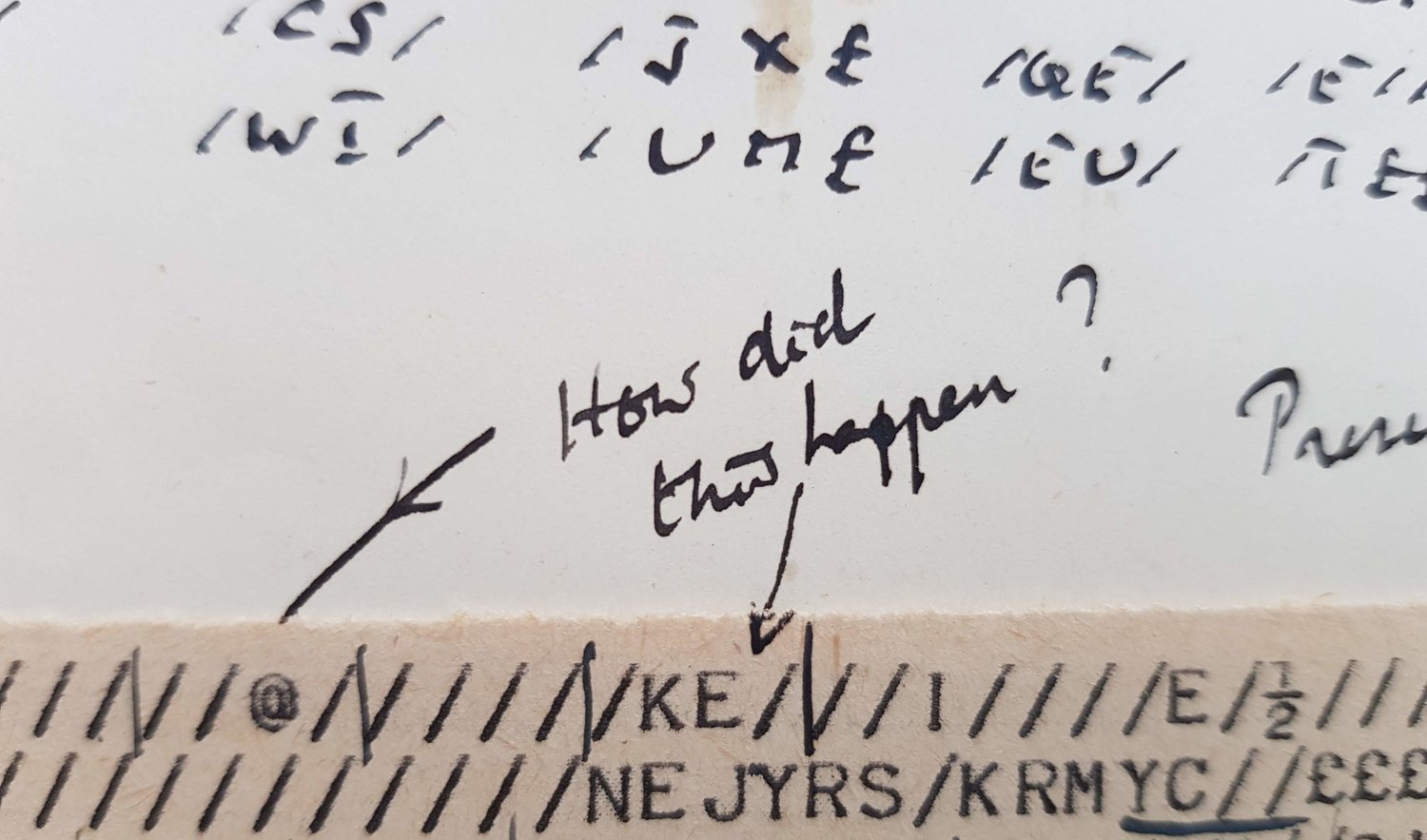(c) King’s College Cambridge. AMT/K.
Alan Turing’s Manchester has been many years in the making. My intention is to use this blog as a way of sharing some of the material that didn’t make it into the book. So it’s appropriate to start with an image I first saw 30 years ago, in King’s College Cambridge, and didn’t understand. I still don’t quite understand it…
It was in 1984 that Andrew Hodges came to Cambridge to talk about his then-new biography of the then-unheard of Alan Turing. I was a maths student at the time, struggling with the discovery that I wasn’t nearly as good as I had thought I was, and I remember Andrew’s rewarding detail that Turing had got a disappointing IIi in his first year exams. But Andrew’s story-telling inspired me beyond that, to go up to the archive of King’s College, where much of Turing’s papers are held, and this is what I saw. It’s in the now vanishingly rare format of a double foolscap page, not far off A3 in size, and this is the most colourful of a handful of similar pages. You can see high resolution images of them now online. (Though that digital archive looks mildly dated these days, that’s actually a reflection of how far-seeing King’s library was in putting it online around 1999 when archivists were less database-familiar. I can remember a discussion in which the compsci person explained he was going to put the images in a MySQL database, which was duly minuted as going into ‘his SQL’ database.)
At the time I thought the big red spots were meant to be blotchy patterns like the ones on Friesian cows. Those kind of spotty patterns are the ones that Turing is mildly famous for; famous that is in the way he was famous before 1984, as an innovative mathematician who tried to model how shape arose in biological form (this is separately to how he had also invented computer science). Apparently I talked about little else for a few weeks, but then I found a girlfriend and forgot all about it.
A few years later, when I found myself back in the same archive, I was a bit better prepared, because in the meantime I had acquired a PhD and started working in exactly that mathematical biology field that Turing was already mildly famous in. What he was famous for was a mathematical idea called the Turing Instability, which was expressed in the mathematical language known as reaction-diffusion equations. By now I knew enough to see this wasn’t just a working out of the Turing Instability — he had long published that by the time of these diagrams — but was an attempt at explaining why Fibonacci numbers arise in plants. I’ve written about that attempt — and the way this Figure fits into it — in some technical papers (most recently here). Oh, and in a book I’m currently trying to plug. And in that book I do explain how, when Turing came to Manchester, and was the first person in the world to have free CPU time to spend, he chose to work on the Fibonacci problem and this Figure was the result.
But what I’ve never quite written about is what I don’t understand about this picture; this will inevitably get super Turing-nerdy. Firstly, while the care and labelling of the images suggest they are intended for publication, there isn’t an obvious figure-shaped hole for them to fit into any of the surviving draft manuscripts. Nevertheless they must be representations of both Fourier space above and real space below, which are discussed at length in the manuscripts Turing left . But beyond that things are unclear. They are derived from calculations on the Ferranti Mark I in Manchester in the years after 1952, but it’s unclear how closely they are related to the surviving teletype output from then. And even then, it’s not at all clear to me what the periodicity is meant to be in the real space — that doesn’t look as though it has periodic boundary conditions in either direction. And exactly how it all fits into Turing’s Fibonacci theory is still unclear. Maybe we’ll never know. I’m writing another book at the moment on phyllotaxis, and may be that will make things clearer. Or maybe someone else will scoop me (I hope so; I’ve got plenty of other problems to solve). Or even better, work with me (get in touch!).
Anyway, it’s very pleasing to have some kind of closure of that morning in the King’s library thirty years ago, even if the closure has just shown me how many questions are still open.

